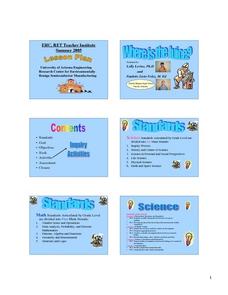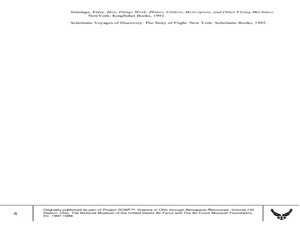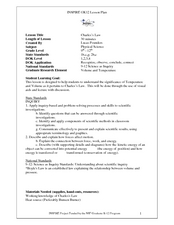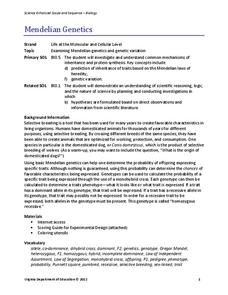Curated OER
Why Is My Bread Fuzzy?
Students explore the organisms that live on counters or surfaces in the classroom. In this mold experiment, students observe mold in different conditons. Students record their observations on a worksheet. Students understand how mold...
Curated OER
Food for Thought
Fifth graders explore the brain and what is needs. In this biology lesson plan, 5th graders will work on a series of activities that will allow them to learn about the brain, its parts, and the best foods to eat for their brain.
Curated OER
Tree-Ring Dating
In this tree-ring dating worksheet, students use activity sheets to determine a tree's age and to observe changes in climate from the tree-rings. Students investigate how archaeologists use tree rings to date evidence and they answer 5...
Curated OER
Smart Consumers
You can help students cut through the hype and find out for themselves which brands are best by becoming consumer scientists.
Curated OER
A Frog's Life Story
Students investigate the lives of frogs by completing several worksheets. In this biology lesson, students discover the life cycle of a frog from tadpole to death. Students complete frog life cycle puzzle as well as create a life cycle...
Curated OER
Where Is The Juice?
Students are introduced to the component's of Ohm's Law. In groups, they practice their problem solving skills by reviewing problems solved earlier. They participate in activities that help them gather information on the importance of...
Curated OER
Parachutes: Is it Surface Area or Shape?
Young scholars investigate how to make a good parachute. In this physics activity, students observe the motion of parachutes as it falls and measure the time. They collect data and calculate the average descent time for each canopy shape.
Curated OER
Photosynthesis and Respiration
Eighth graders differentiate photosynthesis and respiration. In this biology instructional activity, 8th graders draw a diagram explaining these two processes. They answer a quiz after the instructional activity.
Curated OER
Physical and Chemical Changes
Eighth graders distinguish between physical and chemical change. For this chemistry lesson, 8th graders observe a series of demonstrations showing physical and chemical changes. They identify the signs that a chemical reaction took place.
Curated OER
Termite Biology
Students explore the physical characteristics, distribution and habitat of termites. The lesson focuses on the termite as a social creature contrary to most other insects.
Curated OER
Charles’s Law
High schoolers describe the relationship between temperature and volume. In this chemistry lesson, students perform an experiment and record their their results. They use Charles' law to explain their observations.
Curated OER
Electrical Engineers for a Day
High schoolers build a robot out of a 3-¿¿ inch floppy disk drive, two floppy disks, and some other miscellaneous supplies. They apply information they gather about electrical circuits from a web-based circuit design program.
Curated OER
The Effects of Ultra-Violet Light on Yeast
Students work in small groups collecting and analyzing data as they learn how to best grow yeast. This lesson allows students to conduct several student-created experiments as they continually generate questions and hypotheses. ...
Curated OER
Plant Phylogeny
Students examine live potted plants and create a hypothesis regarding their relationships in this upper-level introductory lesson on phylogenetic reconstruction using morphological characters. The lesson can be accomplished in...
Curated OER
Exploring Molecules
Students explore the process of science by studying and analyzing fundamental biological molecules in this introductory lesson plan on molecules. The lesson plan includes a pre-lesson plan worksheet and a question sheet for final,...
Curated OER
Identifying the Relationship Between Black Carbon and the Weather
Students identify the relationship between black carbon and the weather. In this investigative lesson students compare samples of black carbon with a color-scale and analyze others samples.
Curated OER
Dissecting Diets
Students practice making comparisons and evaluating claims regarding different suggested dietary plans using their knowledge of Biological, scientific facts. This lesson plan can be accomplished individually, in small groups, or in a...
Curated OER
A Walk in the Woods
Students observe an environment, ask questions about what they observe. and design experiments to answer one question they came up with in this upper-level High School or college lesson. The lesson requires an outdoor exploration or...
Curated OER
Mendelian Genetics
Learners work collaboratively in small learning groups to create some representation of an aspect of Mendelian genetics in this review lesson for the Biology classroom. The lesson includes task cards for each small group and a...
Curated OER
Who's the Father?
Students analyze gels to determine parentage in this lesson about scientific evidence, investigation, and DNA concepts. The lesson includes a pre-activity worksheet, a final individual assessment, and student handouts for in-class...
Curated OER
An Introduction to Brine Shrimp
Second graders engage in a lesson that seeks to discover information about Brine Shrimp. They conduct research using a variety of print and electronic resources. Students study the type of environment the shrimp need and read about the...
Curated OER
Introduction To Brine Shrimp
Fourth graders engage in a variety of activities in order to find information about the brine shrimp. The lesson includes background information for the teacher to deliver instruction. They make observations of the shrimp in different...
Curated OER
Natural Selection
Students practice calculating allele and genotype frequencies in the framework of a simple simulation using hard candy, calculators, and a worksheet. This lesson includes a three-page worksheet and an assessment question for conclusion.
Curated OER
Biochemistry Taboo
Students play a "Biochemistry Taboo" game using their knowledge of Biological chemistry and taboo cards. This lesson can be used as a review or an introduction into concepts covered in Biochemistry and includes a pre-activity worksheet.

























